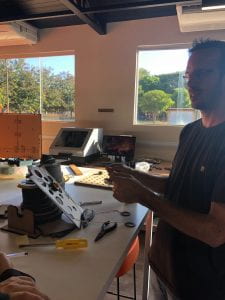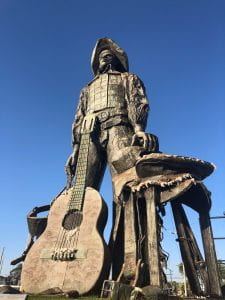This past week was a perfect mix of technical and cultural immersion. We began with a tour of UNIFEB’s new maker space, FEB 360. The space was PRISTINE and came complete with ample workspace, most of the tools any engineers could want or need, teams of undergraduate students tinkering in various corners of the room, and helpful lab techs. One of the lab techs was kind enough to show us around the space and demo some of their projects. While there were massive builds and Rube Goldberg-looking projects scattered about, I was most impressed by a device meant for patients with motor skill complications. At first glance, the device just looked like a propped, rectangular piece of plywood with various-sized, circular cutouts and wooden hooks on each of the top corners. The lab tech then looped a piece of string through the hooks, leaving the two ends to hang down while a “belt” of string rested on the board. He then balanced a wooden ball on the belt and, by varying tension on either end of the string, maneuvered the wooden ball from the bottom to the top of the board without letting it fall through the cut-out holes. I was blown away.
Not only was this device affordable and genuinely entertaining but it was SIMPLE. I began to think of different ways I would have approached building a product for patients with motor skill complications and I was almost embarrassed by how elaborate and complicated each imaginary iteration was in comparison. I could hear my highschool Physics teacher yelling, “Think simple, stupid!” (Hi, Mr. Sload!) Although it was a casual demo of a project, in that moment I learned to respect and value the art of simplicity. So many times I find myself rushing to use each and every tool in my hypothetical-yet-very-convenient-engineering toolbox to solve problems. Not only does that lead to overcomplications and inefficiencies but, especially in the scope of patient care, one also loses sight of the patient’s needs and wants. I look forward to “thinking simple” as we continue to make edits to our technologies in order to develop something effortlessly innovative.
After our tour of the FEB 360, Carol took us on a trip to the Parque do Peão where the annual Barretos rodeo takes place. Anyone who knows me knows that I LOVE THE HOUSTON RODEO. The food. The people. The music. The livestock. I’m ALL FOR IT. So you can imagine my excitement when the opportunity to visit Parque do Peão. (Fun fact: While Barretos has a population of about 120,000 inhabitants, it grows to about 1 million during the Rodeo season. It’s a pretty big deal.) Although the park was pretty empty safe for us and two other families, I began to imagine the place in all its glory during peak Rodeo season. Walking around the park you could really feel how important the cowboy is as a symbol to the people of Barretos– so much so that there is a 27 meter tall cowboy monument in the middle of the park. I loved the little excursion and really hope I can come back to Barretos and witness the Rodeo in all its glory.
The next day, we met with Dr. Sylvio, an orthopedic surgeon at Hospital de Amor. We arrived at the surgical center, changed into our scrubs and hairnets, and met Dr. Sylvio in an operation room. If I’m being honest, I was scared. Actually, I was terrified and could feel my stomach turning into knots as we approached the surgical room. It has always been a huge fear of mine to witness a live surgery which doesn’t really help when you’re a bioengineering student interested in medical technologies. Luckily there were no open wounds in sight once we entered the operation room. Instead, Dr. Sylvio had a model femur laying next to what seemed like a pantry of surgical tools. He went on to demonstrate how metastatic femoral cancer is addressed by implanting metal screws into the femur. The procedure itself can be quite tricky since the placement of the screws and guiding poles are crucial to proper treatment yet each person’s femur has a slightly different shape, size, and bend depending on a multitude of factors. In order to address these problems, multiple surgical tools of various sizes are used yet even the most practiced surgeons like Dr. Sylvio still rely on x-ray imaging to help guide the placement of the screws.
Furthermore, surgeons today must begin by implanting the screw closest to the hip and then implant the second screw closest to the knee due to the way current tools are designed. Ideally, surgeons would implant the distal screw (closest to the knee) and then the one closest to the hip in order to minimize rotation of the bone during surgery. Inserting the first screw near the knee is especially helpful in minimizing radiation exposure during surgery since a guiding pole can be inserted down the femur until it “taps” the metal screw, ensuring proper placement. As such, Dr. Sylvio tasked us with designing a surgical tool capable of enabling doctors to access the distal screw cite. While we already have a pretty good idea of the type of device we would like to design, Dr. Sylvio invited us to shadow a femoral cancer operation this coming Tuesday in order to get a better understanding of the types of limitations surgeons currently face. I’m honored– but also mortified!
Although I’m scared, I am also very grateful for the opportunity. This experience is going to push me far out of my comfort zone and challenge a life-long fear of mine. Although I’m anxious I also know that it is occasions like this that will ultimately allow me to understand a surgeon’s needs and produce a great device. Let’s see how it goes!
On Friday, we received a lovely package from Rice 360 containing the remainder of materials needed for the WounderWoman device. (Thank you, Georgia!) Dr. Vinicius shared many great points with us during our meeting with him and so we got to work dissecting the device and noting future improvements. The device itself does not currently work. There are a couple of leaks which inhibit proper suction to develop, there was visible water leakage into the pump and pressure gauge, the negative pressure seemed to be insufficient, and the electrical components could use some improvement. We noticed that some of the problems could easily be addressed: make new silicone components and properly seal them, introduce back-flow gauges, use a printed circuit board, use more durable tubing, and use a 12 V power source to match the 12 V pump. The WounderWoman device is such a cool concept and we didn’t really want to leave it there. Using the new materials from Rice 360 we will use an Arduino to create a digital interface that informs patients of the pressure, battery life, and when the battery levels are too low or the pressure is not appropriate. We also hope to edit the device such that it can be used remotely as well as be used when plugged into a power outlet (as recommended by Dr. Vinicius).
Overall, I am excited to see how our projects take off. I am beyond happy to be able to work in such a collaborative environment surrounded by so many experts with great feedback. Let’s see how next week goes!
Até logo!
Paula



